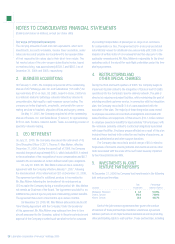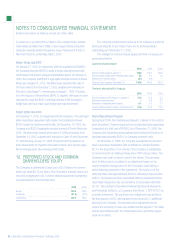LabCorp 2006 Annual Report Download - page 39
Download and view the complete annual report
Please find page 39 of the 2006 LabCorp annual report below. You can navigate through the pages in the report by either clicking on the pages listed below, or by using the keyword search tool below to find specific information within the annual report.
NOTES TO CONSOLIDATED FINANCIAL STATEMENTS
(Dollars and shares in millions, except per share data)
Laboratory Corporation of America® Holdings 2006 37
............................... ........
.......................................
Capitalized Software Costs:
The Company capitalizes purchased software which is ready for
service and capitalizes software development costs incurred on
significant projects starting from the time that the preliminary project
stage is completed and management commits to funding a project
until the project is substantially complete and the software is ready for
its intended use. Capitalized costs include direct material and service
costs and payroll and payroll-related costs. Research and develop-
ment costs and other computer software maintenance costs related to
software development are expensed as incurred. Capitalized software
costs are amortized using the straight-line method over the estimated
useful life of the underlying system, generally five years.
Long-Lived Assets:
Goodwill is evaluated for impairment by applying a fair value based
test on an annual basis and more frequently if events or changes in
circumstances indicate that the asset might be impaired.
Long-lived assets, other than goodwill, are reviewed for impair-
ment whenever events or changes in circumstances indicate that the
carrying amounts may not be recoverable. Recoverability of assets
to be held and used is determined by the Company at the level for
which there are identifiable cash flows by comparison of the carrying
amount of the assets to future undiscounted net cash flows before
interest expense and income taxes expected to be generated by the
assets. Impairment, if any, is measured by the amount by which the
carrying amount of the assets exceeds the fair value of the assets
(based on market prices in an active market or on discounted cash
flows). Assets to be disposed of are reported at the lower of the car-
rying amount or fair value.
The Company completed an annual impairment analysis of its
indefinite lived assets, including goodwill, and has found no instances
of impairment as of December 31, 2006.
Intangible Assets:
Intangible assets (patents and technology, customer lists and non-
compete agreements), are amortized on a straight-line basis over the
expected periods to be benefited, such as legal life for patents and
technology, 10 to 25 years for customer lists and contractual lives
for non-compete agreements.
Debt Issuance Costs:
The costs related to the issuance of debt are capitalized and amor-
tized to interest expense using the effective interest method over the
terms of the related debt.
Professional Liability:
The Company is self-insured for professional liability claims arising
in the normal course of business, generally related to the testing and
reporting of laboratory test results. The Company records a reserve
for such asserted and estimated unasserted claims based on actu-
arial assessments of future settlement and legal defense costs.
Income Taxes:
The Company accounts for income taxes utilizing the asset and
liability method. Under this method deferred tax assets and liabilities
are recognized for the future tax consequences attributable to differ-
ences between the financial statement carrying amounts of existing
assets and liabilities and their respective tax bases and for tax loss
carryforwards. Deferred tax assets and liabilities are measured using
enacted tax rates expected to apply to taxable income in the years in
which those temporary differences are expected to be recovered or
settled. The effect on deferred tax assets and liabilities of a change
in tax rates is recognized in income in the period that includes the
enactment date. Future tax benefits, such as net operating loss carry-
forwards, are recognized to the extent that realization of such benefits
is more likely than not.
Derivative Financial Instruments:
Interest rate swap agreements, which have been used by the Com-
pany from time to time in the management of interest rate exposure,
are accounted for at fair value.
The Company’s zero-coupon subordinated notes contain the
following two features that are considered to be embedded derivative
instruments under Statement of Financial Accounting Standards
(“SFAS”) No. 133 “Accounting for Derivative Instruments and
Hedging Activities”:
1) The Company will pay contingent cash interest on the zero-
coupon subordinated notes after September 11, 2006, if the
average market price of the notes equals 120% or more of
the sum of the issue price, accrued original issue discount
and contingent additional principal, if any, for a specified
measurement period.
2) Holders may surrender zero-coupon subordinated notes for
conversion during any period in which the rating assigned to
the zero-coupon subordinated notes by Standard & Poor’s
Ratings Services is BB- or lower.
Based upon independent appraisals, these embedded deriva-
tives had no fair market value at December 31, 2006 and 2005.
























